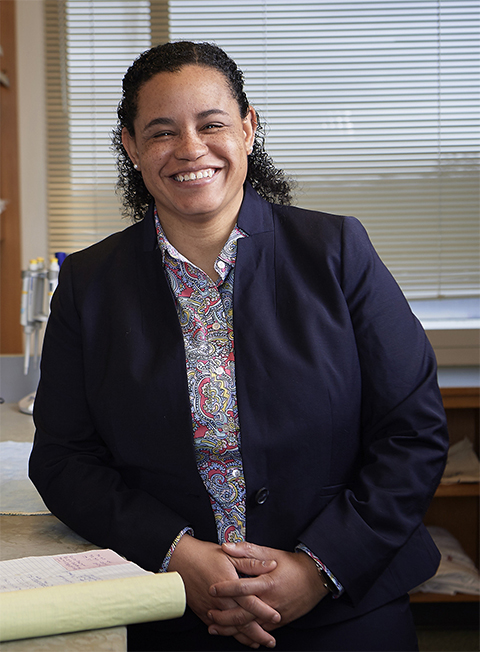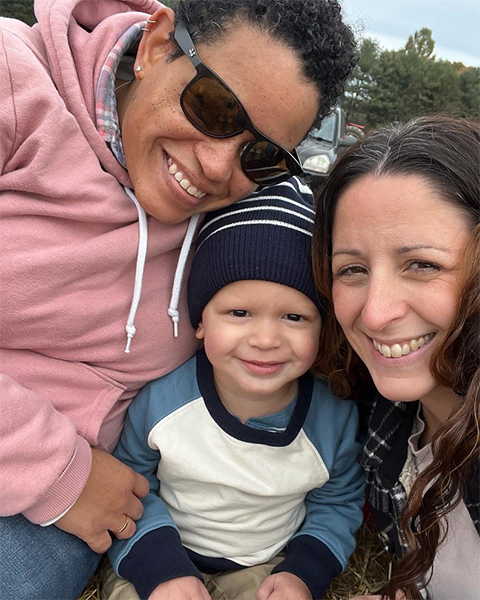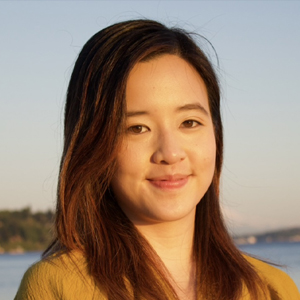Meet Donita Brady
When faced with research challenges during her postdoctoral fellowship, Donita Brady considered going back to her past life as a Division 1 softball player and becoming a coach. However, the role of copper in tumorigenesis caught her eye, and her interest encouraged her to stay in science. Twelve years later, Brady’s team at the University of Pennsylvania still investigates how copper modulates signal transduction in healthy and cancerous cells.
Donita Brady is an associate professor and vice chair of cancer biology and an assistant dean of the Office of Research Trainee Affairs. Brady has been an associate editor for the Journal of Biological Chemistry and co-chaired the 2025 ASBMB annual meeting. She recently discussed her work on metalloallostery and career journey with ASBMB Today.
This interview has been edited for clarity, length and style.

How did you become interested in science?
Brady: My first introduction to the idea of biomedical research happened by sheer luck.
When I was an undergraduate at Radford University in Virginia, I wasn’t particularly drawn to careers in the pharmaceutical or chemical industries, which were what most of my classmates were interested in pursuing. So, my advisor suggested I look into summer undergraduate internship opportunities to get a sense of what research might be about.
I applied to a few places around the country and was accepted to be a Carolina Summer Fellow in the department of pharmacology at the University of North Carolina at Chapel Hill. There, I worked in the laboratory of Channing Der, under the mentorship of Gretchen Repasky, who was a postdoctoral fellow at the time.
That was my first experience in a research laboratory — I had never even held a pipette before. As a chemistry major, I hadn’t encountered concepts like the Ras oncogene or the fundamentals of cancer biology and signal transduction. That summer was my introduction to those topics and their significance in biomedical research. I had a fantastic 10 weeks, and by the end of it, I knew I wanted to pursue graduate school, earn a Ph.D. in pharmacology and ultimately become a professor.
I like to tell this story because, naively, I had no idea about all the things that were going to come between that choice and finally becoming a professor. That was another 14-year journey for me.
What did you study that summer?
Brady: We were trying to understand whether cyclooxygenase enzymes, particularly COX2, would be a good pharmacological target downstream of oncogenic RAS. Cyclooxygenase enzymes are involved in inflammatory processes, so they’re the main targets of nonsteroidal anti-inflammatory drugs. They’re also downstream transcriptional targets of oncogenic RAS, and at the time, new drugs targeting COX2 had just come out. This work ended up laying the foundation for what I did as a Ph.D. student and even as a postdoc, where I tried to identify pharmacologically accessible (targets) downstream of oncogenes.
Throughout your career, have you ever had doubts about pursuing academic research?
Brady: I definitely had some doubts along the way. When I was a postdoc in Christopher Counter’s laboratory at Duke University, I was supposed to be characterizing how the small guanylyl triphosphatases RALA and RALB were important downstream targets of oncogenic RAS, especially in the context of pancreatic cancer. Unfortunately, the conditional knockouts that we made were incorrect, so I was two years into my postdoc without a project.
At that point, I thought, ‘Maybe I need to start thinking about a plan B.’ I felt like I was up the creek without a paddle in a lot of ways. I questioned whether I wanted to do research anymore.
I thought, ‘Maybe I’ll go to pharmacy school and be a Pharm.D. (Doctor of Pharmacy), and that’d be fine. Or be a teacher of some sort. Or go back and coach softball.’ I was a Division I softball player in college.
I basically started considering all the things that I was good at. But luckily, things ended up working out.

Tell me how you worked through the challenges of your postdoc.
Brady: I credit (getting through my postdoc) to having an open mind about what I was willing to work on because my (backup project) led me to work on copper biology, which is what my group still does today.
At the time, another professor at Dennis Thiele, whose graduate student, Michelle Turski was interested in characterizing the fruit fly homolog for the high-affinity copper uptake protein 1, or CTR1, which drives the major way that copper gets into our cells. Back then, it had been known for a few decades that if you add oncogenic RAS to the fly’s eye, you get this visible abnormality called the rough eye phenotype. This student made an insightful observation — that deleting CTR1 completely eliminated the phenotype, which was a very exciting and compelling finding.
So, I was tasked with investigating whether this dependency of oncogenic RAS on CTR1 was also true in mammalian systems. Using a genetic knockout in human embryonic kidney cells, a very broadly used model, we showed that CTR1 was indeed required for this process in mammalian cells.
From that time on, I tried to understand the underlying mechanism of this dependency. I essentially built my career on investigating why the loss of copper would impact RAS tumorigenesis. If I had turned down that project as a postdoc, I don’t know what I’d be doing right now. I’m sure I probably would’ve figured something else out, but it was definitely a pivotal moment, upon which I look back now and can clearly see how it completely shaped my career.
Tell me about the role of RAS and copper in tumorigenesis.
Brady: All cells — normal and cancerous — require copper to fully activate the mitogen-activated protein kinase, or MAPK, pathway. However, in tumor cells, we can specifically disrupt copper binding because these cells have become dependent, or "addicted," to oncogenic MAPK signaling. Interestingly, cancer cells don’t quickly adapt or rewire this copper dependency, which creates a therapeutic window. By introducing a copper chelator, we can dampen the MAPK signaling that tumors rely on for growth. One question that remains, however, is why certain tumors are more sensitive to this approach than others.
Can you tell me about your role in advancing diversity, equity and inclusion at the University of Pennsylvania?
Brady: Over the past ten years, I have focused on addressing barriers to participation in academic medicine and research by expanding access, building strong scientific communities and raising awareness around best practices in education and training.
Through programs I direct, we engage approximately 20 high school students, 60 undergraduates and 20 postbaccalaureate scholars each year. These programs are supported by institutional resources, extramural funding and philanthropic partnerships. I also co-direct PennPORT, a program that facilitates professional development for postdoctoral trainees preparing for academic careers.
In partnership with Penn’s Biomedical Graduate Studies, or BGS, program, I introduced a rubric-based review system — initially for training programs and now adopted across all BGS Ph.D. programs. This approach has allowed for equitable and consistent and has been a key part of sustaining strong recruitment outcomes.
Finally, in the department of cancer biology, I advocated for and supported the adoption of an anonymized faculty search process for tenure-track assistant professor positions. This process removed identifying information during the early stages of review and focused evaluation on research achievement, creativity, impact and mentoring plans.
How do you like being an associate editor for JBC?
Brady: Being an editor at JBC is deeply meaningful to me, especially given my roots in metal biochemistry and signal transduction. These fields sit at the intersection of fundamental chemistry and dynamic cellular processes — areas where JBC has consistently published high-impact, rigorous science. As a graduate student and postdoc, JBC was the journal everyone aspired to publish in. Having a JBC paper felt like a badge of honor, and now, it’s incredibly fulfilling to contribute to the journal in a different way — by helping curate and elevate articles for our readership.
What makes JBC even more special is its model: editorial decisions are made by active scientists who are deeply embedded in the community. I love that it’s a journal run by scientists, for scientists, and it's committed to open access. This ensures that discoveries are accessible to anyone, anywhere. Serving on the editorial board is not just a professional privilege. It’s a way of giving back to the community that helped shape my own scientific journey.
How have your experiences shaped your current lab and approach to training the next generation of scientists?
Brady: One of the core values I try to instill in my group is the importance of teamwork and collaboration in tackling research questions. You don’t need to be an expert in everything. Instead, you should focus on discovering what you’re truly good at, then use those strengths to support and elevate the work of others. That collaborative mindset has been a guiding principle throughout my own training, and it’s something I consistently emphasize with everyone in my lab. Science is strongest when it’s shared.
Enjoy reading ASBMB Today?
Become a member to receive the print edition four times a year and the digital edition monthly.
Learn moreGet the latest from ASBMB Today
Enter your email address, and we’ll send you a weekly email with recent articles, interviews and more.
Latest in People
People highlights or most popular articles

Mydy named Purdue assistant professor
Her lab will focus on protein structure and function, enzyme mechanisms and plant natural product biosynthesis, working to characterize and engineer plant natural products for therapeutic and agricultural applications.

In memoriam: Michael J. Chamberlin
He discovered RNA polymerase and was an ASBMB member for nearly 60 years.

Building the blueprint to block HIV
Wesley Sundquist will present his work on the HIV capsid and revolutionary drug, Lenacapavir, at the ASBMB Annual Meeting, March 7–10, in Maryland.

In memoriam: Alan G. Goodridge
He made pioneering discoveries on lipid metabolism and was an ASBMB member since 1971.

Alrubaye wins research and teaching awards
He was honored at the NACTA 2025 conference for the Educator Award and at the U of A State and National Awards reception for the Faculty Gold Medal.

Designing life’s building blocks with AI
Tanja Kortemme, a professor at the University of California, San Francisco, will discuss her research using computational biology to engineer proteins at the 2026 ASBMB Annual Meeting.

